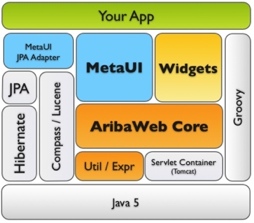AribaWeb by Example
About this Document
This guide is intended to introduce the aspiring AribaWeb application developer
to the key aspects of the framework. Before getting started it is recommended
that you watch in the online screencasts, download the distribution, and explore
the examples. In particular, please view:
This document is organized by "topic" but uses the construction of an ever richer
application as the context for introducing each topic. As such, it is both a reference
guide and a (long winded) step-by-step tutorial.

The AribaWeb Stack
The AribaWeb distribution provides the "full stack" necessary to build database-oriented
business applications with rich AJAX web user interfaces. However, internally the framework
is modular, and applications need not consume all components of the stack. For instance,
many applications build on top of the Widgets + AribaWeb (Core) components, but
provide their own mechanisms for database persistence.
The stack consists of the following major components:
AribaWeb (Core)
The core component-oriented request handling engine. Includes servlet adaptors to bind AW into a
container, the AWComponent and AWElement hierarchy, template parser, and
built-in tags for control flow (AWIf, AWFor, etc), HTML constructs
(AWTextField, AWPopup, ...) as well at the client-side javascript libraries
to deliver an AJAX user experience (incremental refresh, drag/drop, ...)
Util and Expr
Util contains low-level utility classes used by the other AW components. Includes logging,
collection wrappers, performance metric and debugging tracing utilities, as well
as "ClassExtension" and "FieldValue" support for AOP-like external class
extension, and JavaBeans-like high-performance property access.
Expr is a simple expression parser/interpreter that can be used in AW tag bindings
and metaui property definitions. Based originally on OGNL code, but with a
more Java/Groovy-inspired syntax and using ariba.util.fieldvalue for high-performance
property access.
Part I of the Guide focusses on building applications at this level using just these components.
Building atop the AribaWeb core is...
- Widgets
Higher level UI components for building AribaWeb applications. Includes:
- Layout components (PageWrappers, TabSet, SectionHead/Body, PortletWrapper)
- Controls (PopupMenu, Chooser, Calendar)
- Validation display / navigation UI (ErrorFlag, ...)
- DataTable, PivotTable and Tree/Outline support
- RichText editor, Flash Charting
- Wizard framework (multi-step UIs)
Several of these controls provide a rich user interface via associated client-side
JavaScript libraries (e.g. type-ahead choosers, scrolling and dynamic data retrieval
in tables).
Part II of the Guide introduces the Widgets framework.
To automate building part or all of the user interfaces based on model object metadata, applications may adopt...
- MetaUI
Meta-data driven UI framework, built on the full AribaWeb stack for generating
complete user interfaces "on the fly" based on various sources of meta data
(java class introspection, annotations, and ".oss" files). Uses CSS-like
"multi-dimensional selectors" to contextually specify properties.
Supports generating forms (with validation), tables, as well as
global application navigation (e.g. nav tabs) and actions (global and instance-level)
Note that MetaUI may be used with POJOs as well as (when a persistence framework is involved) persistent objects.
Also, while MetaUI automates dynamic
assembly of AribaWeb/Widgets interfaces, it does not "mask" the underlying
framework - applications can build reusable components at the AribaWeb/Widgets level and bind them in to MetaUI
generated interfaces, and can use MetaUI to produce Forms, Tables, or Navigation in the context of an otherwise template-specified UI (in fact, the
Demo application included in the distribution builds at this level).
Part III of the Guide addresses programming at this level of the stack.
MetaUI can further automate the creation of complete database applications via...
- MetaUI-JPA
Binds MetaUI to a Java JPA-provided persistence engine (powered, by default, by Hibernate).
Business objects can be annotated with JPA annotations (e.g. @Entity, @OneToMany, etc) and JPA
with generate a database schema and support persisting and retrieving object instances. MetaUI-JPA
further processes these annotations (and those for the Compass search framework) to create MetaUI rules
that influence the generated UI.
Part IV will cover these kinds of apps.
Where to Go from Here
The presentation of AribaWeb topics is divided into four majors chapters:
Next: Part I: AribaWeb Core